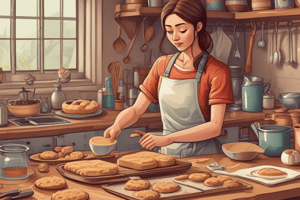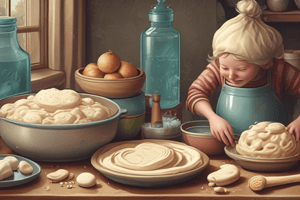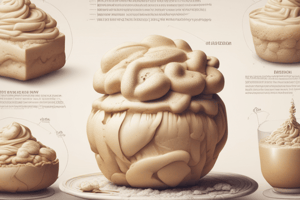Podcast
Questions and Answers
What happens to the structure of native starch when it absorbs water?
What happens to the structure of native starch when it absorbs water?
- It loses its properties
- It becomes doubled in size
- It breaks down
- It remains the same (correct)
What is the role of damaged starch in a dough system?
What is the role of damaged starch in a dough system?
- As a yeast activator
- As a dough softener
- As a filling agent (correct)
- As a binding agent
What affects the elasticity of the dough?
What affects the elasticity of the dough?
- Glutenin (correct)
- Native starch
- Gliadin
- Damaged starch
What happens to the gluten chains during overmixing?
What happens to the gluten chains during overmixing?
What is the result of a longer mix on the gluten structure?
What is the result of a longer mix on the gluten structure?
What is the result of a shorter mix on the gluten structure?
What is the result of a shorter mix on the gluten structure?
What happens to the gluten chains during mixing?
What happens to the gluten chains during mixing?
What is the change in the dough rheology due to the formation of gluten?
What is the change in the dough rheology due to the formation of gluten?
What happens to the dough as visco-elastic properties develop?
What happens to the dough as visco-elastic properties develop?
Why is it necessary to mix protein in first speed for at least 5 minutes?
Why is it necessary to mix protein in first speed for at least 5 minutes?
What is the result of switching to second speed too early during mixing?
What is the result of switching to second speed too early during mixing?
What is the effect of wet dough on fermentation activity?
What is the effect of wet dough on fermentation activity?
What is the result of dough oxidation during mixing?
What is the result of dough oxidation during mixing?
What is the effect of overmixing on the carotenoid pigments in the dough?
What is the effect of overmixing on the carotenoid pigments in the dough?
What is the role of micro cells of air in the dough during fermentation?
What is the role of micro cells of air in the dough during fermentation?
How can the baker minimize the negative effect of oxidation on the dough?
How can the baker minimize the negative effect of oxidation on the dough?
Flashcards are hidden until you start studying
Study Notes
Physical Changes During Dough Formation
- Flour components, primarily starch and protein, are hydrated when they come into contact with water.
- There are two main types of starch: native starch, which absorbs water on the outside of the particle, and damaged starch, which absorbs close to its own weight in water.
- Both native and damaged starch act as filling agents in a dough system.
- The two primary proteins in wheat, glutenin and gliadin, are responsible for dough formation and can absorb 200-250% of their weight in water.
- Glutenin affects the elasticity of the dough, while gliadin affects its extensibility.
- When glutenin and gliadin proteins absorb water, they inflate and become attracted to each other, forming chains of proteins called gluten.
Gluten Development
- The mechanical operation of the dough hook works the gluten into an organized structure through two distinct movements: stretching and folding.
- This process creates a three-dimensional gluten structure, with longer, finer, and more overlapped chains of gluten.
- A longer mix generates a well-developed gluten structure, while a shorter mix generates an underdeveloped one.
- Overmixing can break the gluten chains, leading to a weaker gluten structure.
Chemical Changes During Dough Formation
- Two main natural chemical reactions occur during mixing: fermentation activity and enzyme activity.
- The rate of these reactions depends on the quantity of water used.
- Wet dough generates faster fermentation activity, which may require reducing the level of yeast needed in the formula.
- Oxidation occurs during mixing, incorporating oxygen into the dough and affecting gluten bonds and pigments.
- Too much oxygen can lead to a whiter crumb color and a blander flavor, while some oxygen is necessary for better gluten bonds and tolerance.
Oxidation and Its Effects
- Overmixing can lead to too much oxygen incorporation, negatively affecting carotenoid pigments and resulting in a whiter crumb color and a blander flavor.
- Salt can be used to slow down chemical reactions, including oxidation, and minimize its negative effects.
- Incorporating salt at the beginning of mixing can retard oxidation, while delaying salt incorporation can lead to a whiter crumb structure but at the expense of flavor.
Studying That Suits You
Use AI to generate personalized quizzes and flashcards to suit your learning preferences.




